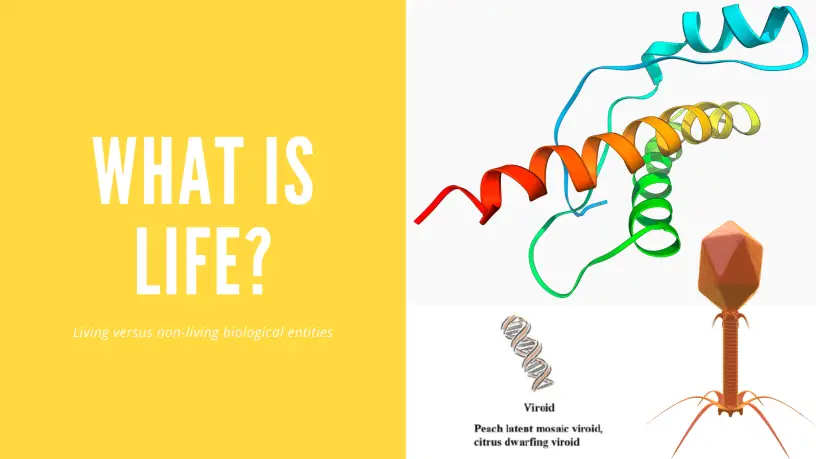Classification of life
Biology is the study of life. Once upon a time, there were just two types of lifeforms, animals and plants. If something wasn’t clearly an animal, well, it was classified as a plant, which included fungi, algae and even bacteria. Today, we can see the errors in judgement of this two category system for which the science of biology was named and founded. Today though, with great advancements in taxonomy based on molecular biology, the distinctions between these various lineages are very clear. However, that is for what we can neatly and completely classify as life. The grey areas of recent biology are in the microbiological world, not prokaryotic cells, but even smaller than that, the complex aggregations of chemicals that sit at the interface between life and non-life. Are they extraordinarily complex aggregations of chemicals or extraordinarily simple forms of life? It is open to debate, and a fascinating one it is. We start our discussion below by considering what life is, then covering an overview of prions, viroids and viruses as the three biological entities, infectious biological entities, that appear not to fit the definition of life, at least not as we currently know and define it.
Criteria for life
A fascinating aspect of biology is delving into the criteria of what is life. What are living and non-living entities in the biological world? Animals, plants, fungi and the various Protisan macro- and microorganisms are quite obviously life, as are Bacteria and the other forms of prokaryotic life, the Archaea. However, where does that leave the sub-cellular biological entities that are not capable of free existence? Parker (1953), in American Scientist 41:614, said that four (main) criteria defined – growth, movement, reproduction and metabolism. Certainly, these are a bit vague, like for example what does “movement” mean? Does that mean plants are non-living as they don’t fulfil these criteria? It is an interesting debate, a debate that has been complicated with the discovery and in-depth analysis of biological entities that fit few of the criteria of life, yet are dominant in their specific ecological niche. Earlier, it just just viruses, but then the discovery of viroids and subsequently prions, has just really opened up a whole new world of parasitic relationships and indeed, has really redefined parasitism.
Really though, should we care? should it bother us? is this purely of academic, scholarly interest only and something that has not practical value in the “real-world”? Perhaps, yes, but the natural world, and it’s categories have always been an important way or ordering what we see. This started of course with Linnaean taxonomy, based on phenotypic differences, which has led to molecular-based differentiation. Ordering the natural world, the biological world, allows a systematic investigation and therefore one would think, a more thorough analysis of the significant challenges that each one of these presents to humanity, either directly or indirectly.
Direct impact can of course be human disease, but then we have indirect impacts through economic losses of agricultural crops or livestock. Thus, these sub-cellular biological entities that sit at the boundary between living and non-living have certainly been able to wreak substantial chaos on humanity.
Prions
Prion diseases are a group of rare, fatal neurodegenerative diseases that affect humans and animals.
Prion diseases are caused by an infectious agent called prions. Prions are misfolded proteins that can cause other proteins to misfold in the same way. They are the only known biological agents that can replicate themselves without a nucleic acid template in the host cell. The disease is transmitted when people or animals eat food contaminated with the prion protein.
The most common form of human prion disease is Creutzfeldt-Jakob disease (CJD). CJD affects about one person per million each year worldwide. It usually starts with personality changes, difficulty walking, and problems with coordination. As the disease progresses, mental function becomes impaired and involuntary jerking movements may appear. Death usually occurs within a year of diagnosis, often from respiratory or cardiac failure.
Viroids
A viroid is a type of virus that infects plants. Viroid infection can cause stunting, wilting, and yellowing of the plant.
Viroid infection can be caused by a number of different types of viroid. The most common type is the potato spindle tuber viroid (PSTVd). This viroid is transmitted by aphids and causes the potato to produce misshapen tubers.
Viruses
A virus is a small infectious agent that can only replicate inside the living cells of other organisms. Viruses can infect all types of life forms, from animals and plants to microorganisms, including bacteria and archaea.
Viruses consist of two or three parts: genetic material made from either DNA or RNA; a protein coat called a capsid; and sometimes an envelope of lipids that surrounds the virus. The genetic material inside the virus may be single-stranded or double-stranded DNA or RNA. The capsid is made from proteins and sometimes contains materials like metal ions which give the virus its shape. The envelope is made from lipids (fats) and proteins, but no genetic material.

